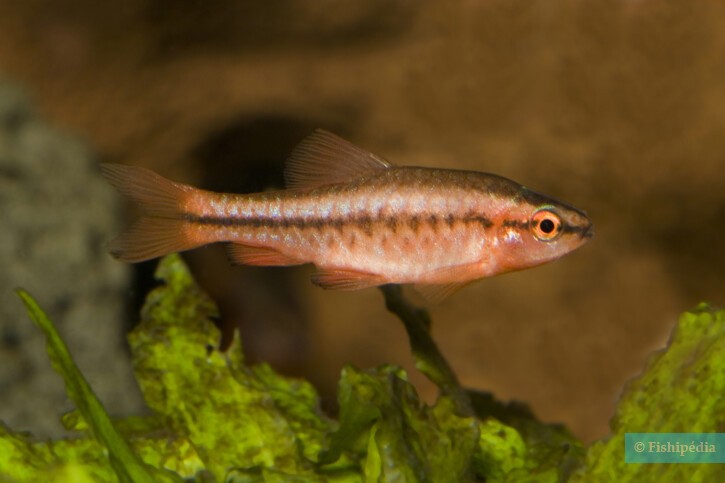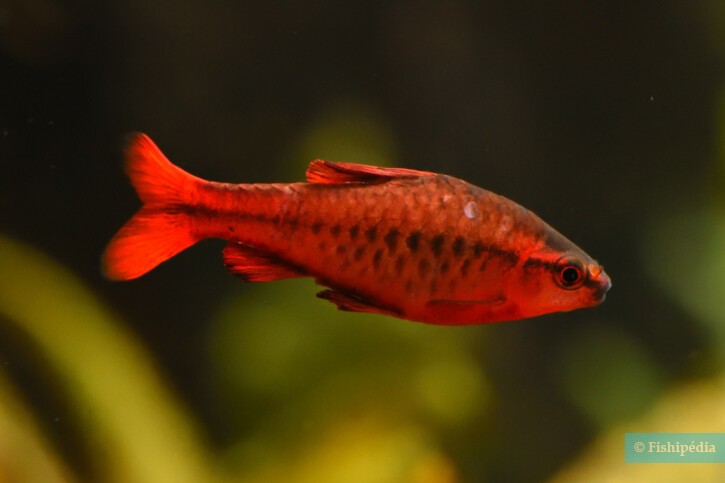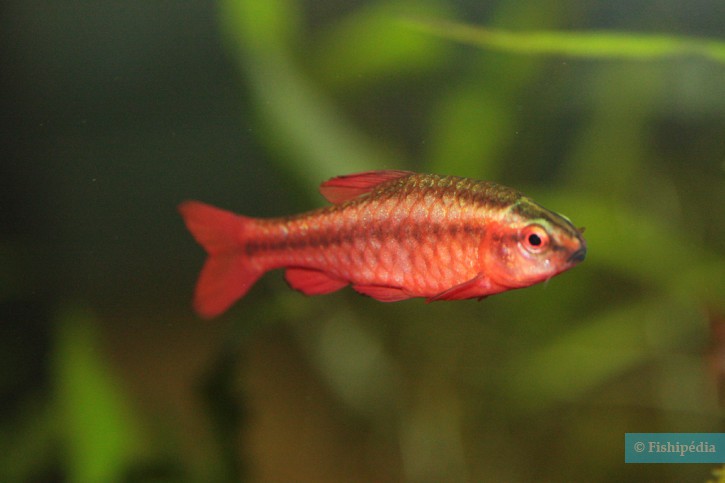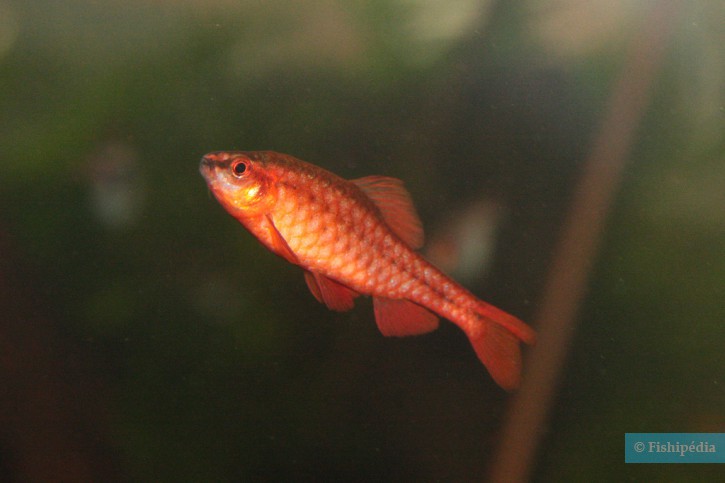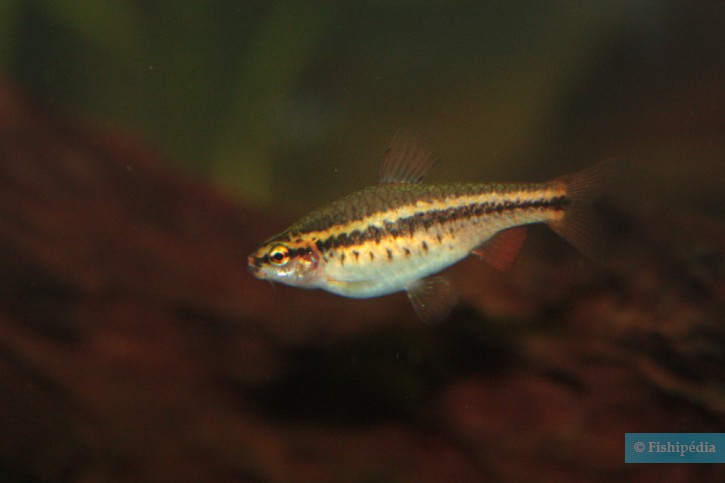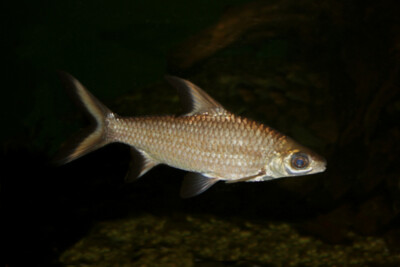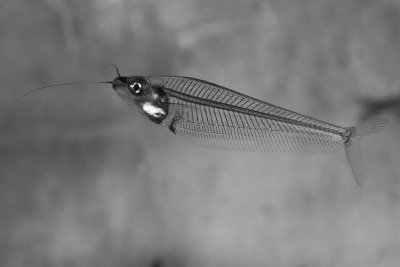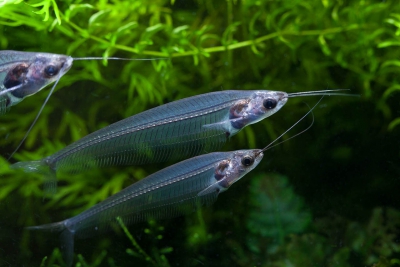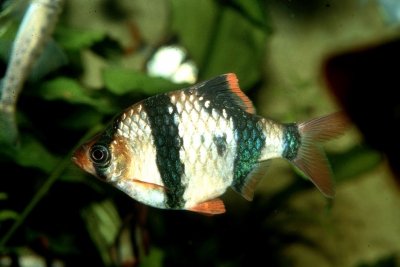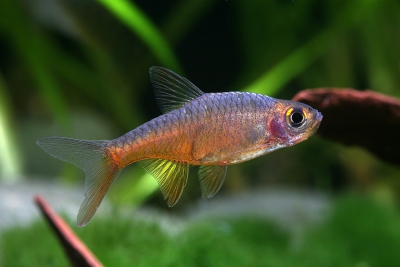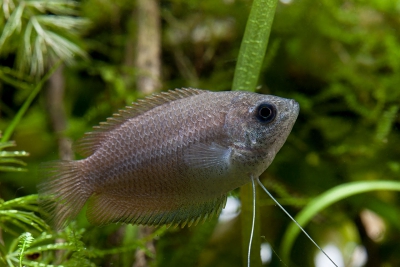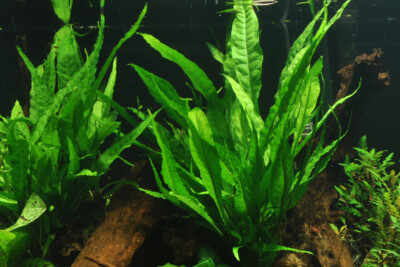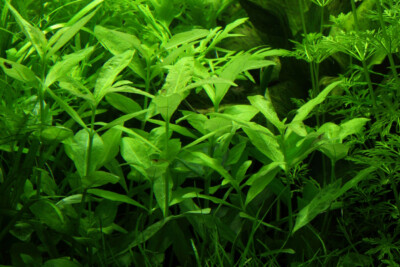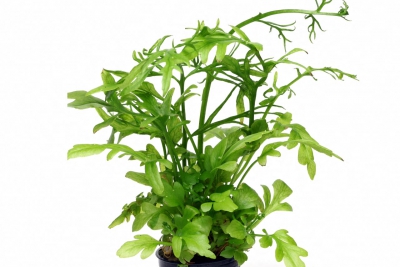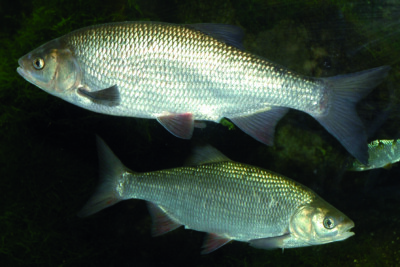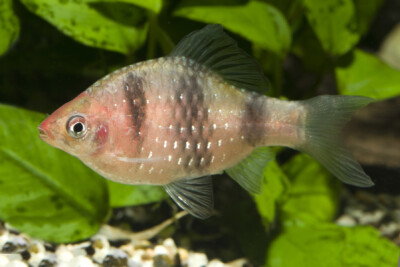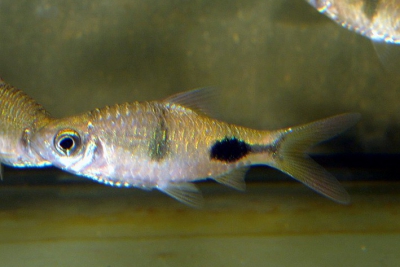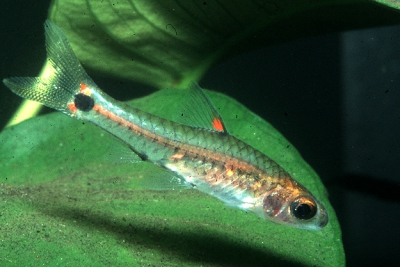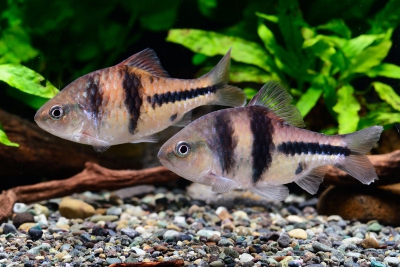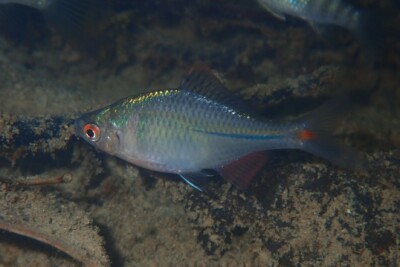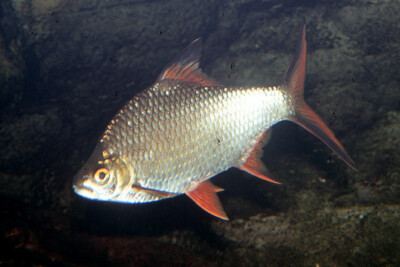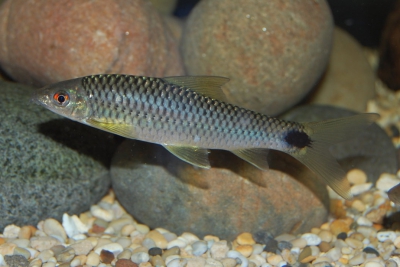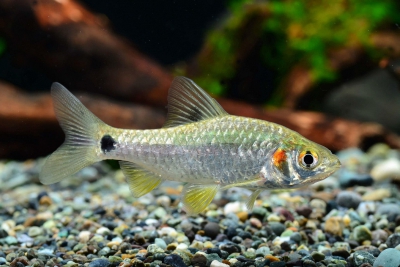cherry barb
| Scientific name | Puntius titteya |
|---|---|
| Descriptor | Deraniyagala |
| Year of description | 1929 |
| IUCN category (World) | VU |
| Family | Cyprinidae |
| Genus | Puntius |
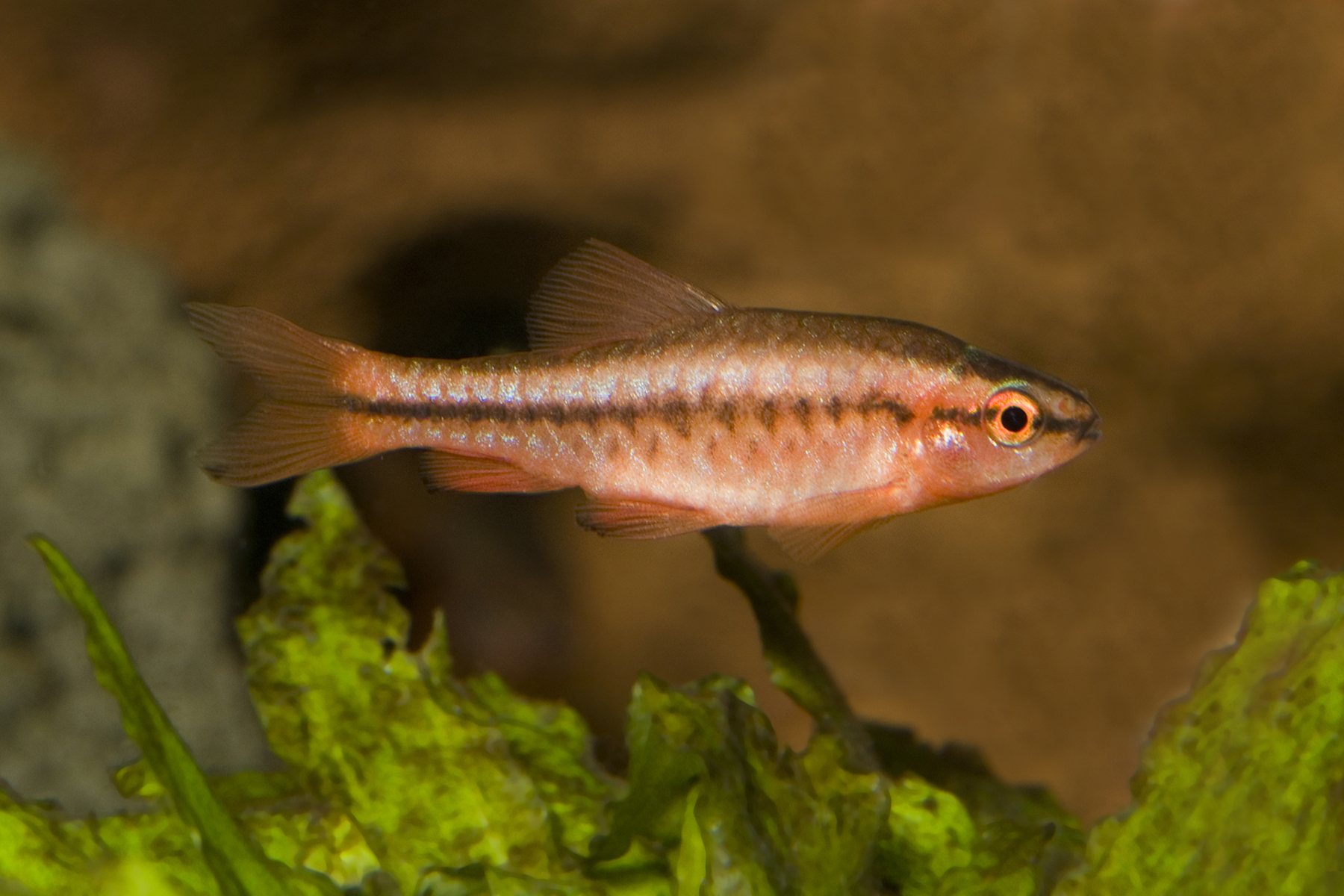

Introduction
Puntius titteya, more commonly known as the cherry barb, is a small freshwater fish endemic to southwestern Sri Lanka. Following a field study published in 2019, this species is considered vulnerable according to the IUCN. It is particularly threatened by hydroelectric projects, domestic and agricultural pollution, and deforestation.
The removal of the most colorful individuals for the ornamental fish trade may have weakened certain populations and contributed to genetic impoverishment. Since a 1996 law, this fish species is restricted for export.
In the trade, fish of breeding origin are encountered. This species is sometimes still classified under the scientific names Capoeta titteya or Barbus titteya.
Who is it?
Morphology
-
Average size3 cm
-
Maximum size5 cm
-
Longevity5 year
-
Mimicryplants
-
Patternrayure horizontale
-
Average size3 cm
-
Maximum size5 cm
-
Longevity5 year
-
Mimicryplants
-
Patternrayure horizontale
How to recognize This fish ?
In the wild, the body is mainly silver with a brown horizontal line. The anal, dorsal, and caudal fins are red, almost transparent. Individuals encountered in trade have more pronounced colors, with an orangish to reddish body. These morphs result from long breeding phases of selection.
Sexual dimorphism
Males have longer fins than females. The body color is also more red and has a higher color saturation. Females are characterized by a reddish area around the gill cover (cheek level).
Behaviour & Life cycle
-
dietomnivorous
-
Sociabilitygregarious
-
territorialNo
-
Way of livingdiurnal
This gregarious species lives in small groups in shallow areas of shaded streams.
Adults are omnivorous. They mainly feed on green algae, detritus, diatoms, dipterans, and animal matter.
Reproduction
-
Reproductionovipare qui dépose ses Œufs dans la végétation
Reproduction is multiple, with group matings involving several males and females. The female lays between 200 and 300 eggs that fall into vegetation shortly after fertilization. Incubation is rapid, with the young hatching after 36 to 48 hours. At a temperature between 26 and 28°C, the fry reach the juvenile stage after 45 to 60 days, and the adult stage after 6 months.
Harmless species
This species does not pose any particular danger to humans if encountered in its natural habitat.
Origin and distribution
Geographic distribution & Conservation
This species is endemic to Sri Lanka. It is found in slow-moving streams in the southwest districts, namely Kalutara, Gampaha, Colombo, Matara, Galle, Ratnapura, and Kegalle. The entire region constitutes the wetland area of the lowlands.
Populations are in constant decline. The main identified causes are hydroelectric projects, environmental pollution, and the development of invasive species. Since the export of the species is restricted, the main threats related to the ornamental fish trade are linked to illegal capture and poaching.
The main threat comes from the development of hydroelectric projects that divert water, modify downstream flows, and alter turbidity and temperature fluxes. Coupled with deforestation, these projects also lead to the drying up of different wetland areas where the species is listed.
In 2020, the species has no populations present in protected areas.
Conservation status of populations (IUCN)
What is its habitat?
Natural environment characteristics
-
Temperature22 - 27 °C
-
pH (acidity)6 - 7
-
gh (hardness)6 - 10
-
FlowSlow and Stagnant
Biotope presentation
The cherry barb is found in shallow waters in shaded streams. The waters are generally transparent.
The environment is characterized by the presence of numerous plant debris (leaves, roots, etc.) and plants (aquatic, semi-aquatic).Main recommendations for fishkeeping
Deontology
In order to preserve wildlife, if you acquire this animal, it must not be released into the wild. See also, the Fishipedia charter.
Fishipedia supports the practice of responsible and environmentally friendly aquarium keeping. We encourage maintenance if it is motivated by a desire to understand the biological functioning of living things and if it is done with respect for animal life.
We believe that aquaristics is an opening to the discovery of aquatic environments, especially freshwater, and that this knowledge is necessary to better protect and respect these environments. Logically, we refute the compulsive purchase of animals that would not find a sufficient and / or adapted place in the host aquarium.
Our recommendationsThese tips apply to adult species from breeding. With regards to water conditions, wild species or close relatives must be kept under the same conditions as in their area of origin.
-
Min volume80 liters
-
Population min5
-
Temperature22 - 27 °C
-
pH (acidity)6.8 - 7.2
CharacteristicsThe characteristics below apply for adult species. They correspond to an average of cases, validated in maintenance condition.
-
Difficulty breedingThe farming difficulty is relative. It depends on experiments already carried out with similar species. First, it takes into consideration the robustness of the species, the ease of recreation of a favorable environment and the general behaviour with the other inhabitants of the aquarium.easy
-
Robustnesstolerant
-
Behaviourpeaceful
-
Availabilitystandard
Recommended equipment from our partners
-
Aquarium
-
Filtration
General reminders
It is strongly advised to read the complete dedicated file and to get information on the feedbacks of maintenance of the envisaged animal, this to avoid any potential conflict whose end result is generally the death of the individual (or the other inhabitants). It is important not to overload your aquarium to limit pollution. This will make maintenance easier.
In nature, animals are subject to weather conditions and live in waters with variable characteristics. The recommendations offered by our team for aquarium maintenance are a guidance and cannot be assimilated to scientific datas.
General reminder on maintenance datas
Le démarrage d'un aquarium est une partie primordiale pour l'équilibre et le bien-être des poissons. Lorsque l'on met en eau un aquarium, l'eau passe naturellement par un cycle biologique : le cycle de l'azote. Celui-ci dure environ trois semaines. Tous les 2 jours, nous vous conseillons de tester votre eau jusqu'à ce que le taux de nitrite soit à zéro pendant plusieurs jours d'affilée.
Pour accélérer ce cycle, vous pouvez utiliser un activateur de bactéries comme JBL Denitrol. Cette solution riche en bactéries vivantes et enzymes permet une mise en place rapide du cycle de l'azote. Les poissons peuvent alors être introduits plus rapidement.
Il est important de tester l'eau de son aquarium régulièrement pour maintenir un environnement sain pour les poissons et les autres habitants. Les tests d'eau permettent de mesurer les niveaux de différents paramètres tels que le pH, la dureté totale, ainsi que les taux de nitrates, de nitrites et d'ammoniaque.
Pour réaliser ces tests, vous pouvez utiliser des produits d'analyse spécialisés tels que JBL ProScan qui permet de réaliser un diagnostic de l'eau directement via un smartphone. Il existe également des coffrets de tests plus classiques de bandelettes, comme JBL PROAQUATEST.
En cas d’usage de l’eau du robinet, vous pouvez utiliser un conditionneur d’eau de type Biotopol de JBL pour éliminer les substances nocives comme le chlore, le cuivre, le plomb et le zinc. Les conditionneurs d'eau garantissent une meilleure santé aux poissons et une meilleure croissance des plantes.
Chlorine and chloramine are dangerous for the health of animals. Used to disinfect water, these agents are present in significant quantities in tap water. We recommend using an anti-chlorine agent every time you change the water. In addition to chlorine, treatments and medicines sold for aquarium use sometimes contain dangerous heavy metals in high doses.
Specific needs for the cherry barb
The cherry barb is a species which lives naturally at a temperature between 22 °C and 27 °C. For proper maintenance, the temperature should never exceed the 30°C for long periods. Nitrate levels should remain below 50mg/L. To keep the water clean and unpolluted, plan on changing 20% to 30% of the water volume each month.
Breeding this species is accessible to any hobbyist. It is recommended to follow some basic rules and to be rigorous to achieve a good maintenance.
This species is particularly common in the aquarium trade. Animals from long-term breeding are usually acclimatized at a temperature of about 26 °C in neutral water.
Cohabitation & Environment
Being a gregarious fish, it is advisable to install at least 5 individuals in an aquarium of 80 liters minimum. Group maintenance is a prerequisite to ensure their well-being. Lonely individuals tend to quickly become stressed and become especially susceptible to disease. Although sometimes certain groups can "merge", mixing several gregarious species living in the same zone of life is not recommended if the volume is not consequent.
The cherry barb is a peaceful species that generally does not exhibit behavioral problems in a community aquarium.
It should be noticed that this species should not be kept with large crustaceans or fish, as it would become a prey of choice. Smaller species should preferably be inserted in the aquarium some time before the larger ones. Moreover, if you want to breed it, it is better to put them in a specific aquarium.The species enjoys a particularly vegetation-rich environment. The addition of plants will provide many useful hiding places for resting. These areas are also conducive to possible breeding in the aquarium. Floating plants such as Salvinia can be added to recreate the subdued atmosphere characteristic of its living conditions in the wild.
Tips for feeding
The cherry barb is omnivorous.
This species can eat dry food (flakes, pellets), fresh food and frozen food. To avoid deficiencies, it is recommended to vary the types of food.
You should not overfeed your residents to avoid polluting the water. For most species, it is better to feed a few small portions each day rather than one large meal.
Food recommendations from our partner JBL - Products PRONOVO
-
Granules
-
Flakes
-
Sticks
Reproduction protocol
-
Maintenance difficultyhard
-
Spawning cleaningNo
-
egg-laying protectionNo
-
Fry protectionNo
Hybridization risks
In general, it is advised not to mix several species of the same genus or different varieties of the same species, to avoid the risks of hybridization.
These animals might interest you
These plants might interest you
Plants play a crucial role in aquariums, both for their ability to filter water by absorbing excess nutrients and for their aesthetic contribution. They provide fish with natural hiding places, can serve as breeding sites, and generally help maintain the overall balance and optimal conditions of the aquarium. The selection presented here includes species from the same regions as the species described on this page, although they do not necessarily come from its exact natural biotope.
To go further
Sources & Contributions
Participation & Validation
The Fishipedia team and specialist contributors are committed to providing high-quality content. However, although the information comes from scientific sources or testimonials from specialists, the cards may contain inaccuracies.

Jérôme Picard

Benoit Chartrer
Translation
Translation done with the valuable contribution of our translators, who make this information available to a wider audience. We sincerely thank them for their commitment.
Bibliographic references
Captive Breeding and Rearing of Fry and Juveniles of Cherry Barb (Puntius titteya Deraniyagala), a Highly Threatened Endemic Fish Species in Sri Lanka - T. V. Sundarabarathy - U. Edirisinghe - C. M. B. Dematawewa - Tropical Agricultural Research - 2004.
Scientific partners
Species of the same family
Same genus
